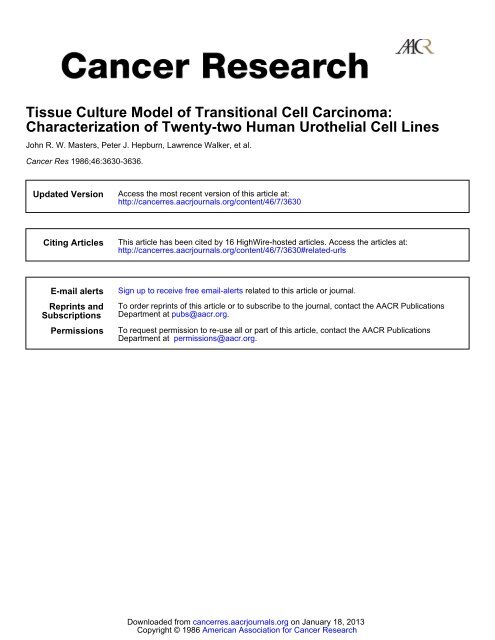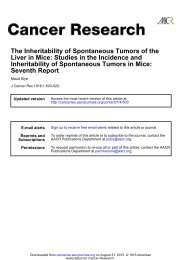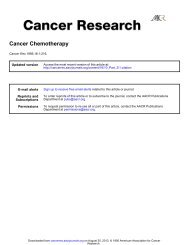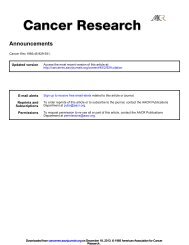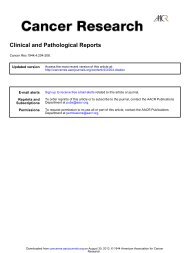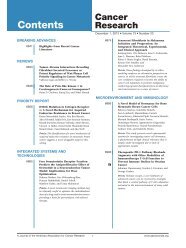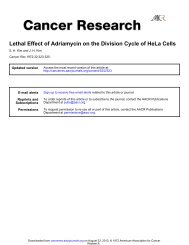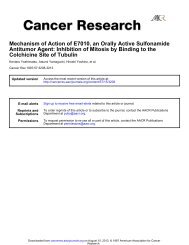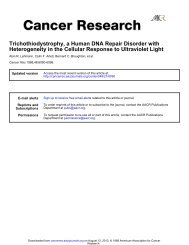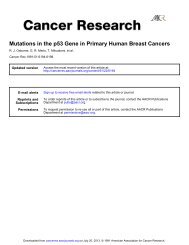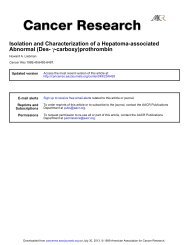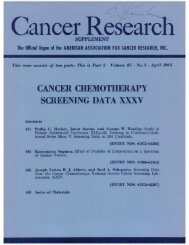Tissue Culture Model of Transitional Cell ... - Cancer Research
Tissue Culture Model of Transitional Cell ... - Cancer Research
Tissue Culture Model of Transitional Cell ... - Cancer Research
Create successful ePaper yourself
Turn your PDF publications into a flip-book with our unique Google optimized e-Paper software.
<strong>Tissue</strong> <strong>Culture</strong> <strong>Model</strong> <strong>of</strong> <strong>Transitional</strong> <strong>Cell</strong> Carcinoma:<br />
Characterization <strong>of</strong> Twenty-two Human Urothelial <strong>Cell</strong> Lines<br />
John R. W. Masters, Peter J. Hepburn, Lawrence Walker, et al.<br />
<strong>Cancer</strong> Res 1986;46:3630-3636.<br />
Updated Version<br />
Citing Articles<br />
Access the most recent version <strong>of</strong> this article at:<br />
http://cancerres.aacrjournals.org/content/46/7/3630<br />
This article has been cited by 16 HighWire-hosted articles. Access the articles at:<br />
http://cancerres.aacrjournals.org/content/46/7/3630#related-urls<br />
E-mail alerts Sign up to receive free email-alerts related to this article or journal.<br />
Reprints and<br />
Subscriptions<br />
Permissions<br />
To order reprints <strong>of</strong> this article or to subscribe to the journal, contact the AACR Publications<br />
Department at pubs@aacr.org.<br />
To request permission to re-use all or part <strong>of</strong> this article, contact the AACR Publications<br />
Department at permissions@aacr.org.<br />
Downloaded from<br />
cancerres.aacrjournals.org on January 18, 2013<br />
Copyright © 1986 American Association for <strong>Cancer</strong> <strong>Research</strong>
[CANCER RESEARCH 46, 3630-3636, July 1986]<br />
<strong>Tissue</strong> <strong>Culture</strong> <strong>Model</strong> <strong>of</strong> <strong>Transitional</strong> <strong>Cell</strong> Carcinoma: Characterization <strong>of</strong><br />
Twenty-two Human Urothelial <strong>Cell</strong> Lines<br />
John R. W. Masters,1 Peter J. Hepburn, Lawrence Walker, Wilma J. Highman, Ludwik K. Trejdosiewicz,<br />
Susan Povey, Mohamed Parkar, Bridget T. Hill, Peter R. Riddle, and Leonard M. Franks<br />
Department <strong>of</strong>Histopathology, St. Paul's Hospital, Institute <strong>of</strong> Urology, 24 Endell Street, London WC2H 9AE, United Kingdom [P. J. H., J. R. W. M., L. W., W. J. H.,<br />
L. K. T.]; Gallon Laboratory, M. R. C. Human Biochemical Genetics Unit, University College, 4 Stephenson Way, London NWl 2HE, United Kingdom [S. P., M. P.];<br />
and Imperial <strong>Cancer</strong> <strong>Research</strong> Fund, Lincoln's Inn Fields, London WC2A 3PX, United Kingdom [B. T. H., P. R. R., L. M. F.J<br />
ABSTRACT<br />
Twenty-two continuous cell lines derived from normal and neoplastic<br />
urothelium, maintained under identical culture conditions, were charac<br />
terized in terms <strong>of</strong> isozyme phenotype, tumorigenicity, and xenograft<br />
morphology following xenotransplantation to nude mice, cylological ap<br />
pearance, in vitro growth rate, labelling index, and colony-forming effi<br />
ciency, in parallel with separate studies <strong>of</strong> in vitro drug sensitivities and<br />
monoclonal antibody reactivities. Three groups were identified: (a) dis<br />
tinct lines with differing isozyme patterns, a broad spectrum <strong>of</strong> growth<br />
characteristics, and xenograft morphologies similar to the histopathology<br />
<strong>of</strong> the parent tumors after periods <strong>of</strong> up to 17 yr following establishment<br />
in vitro; (b) cross-contaminated sublines (maintained separately in differ<br />
ent laboratories for periods <strong>of</strong> up to 10 yr), with identical isozyme patterns<br />
and similar growth characteristics, but differing markedly in tumorigenic<br />
ity and xenograft morphology; and (c) lines derived from normal uro<br />
thelium which were nontumorigenic and had an isozyme pattern usually<br />
only encountered in untransformed cells. These data indicate that cell<br />
lines representative <strong>of</strong> human transitional cell carcinomas can be selected<br />
on the basis <strong>of</strong> xenograft morphology and isozyme patterns, and that a<br />
panel <strong>of</strong> lines derived from normal and neoplastic urothelium could<br />
provide a model system to study the biology and treatment <strong>of</strong> this disease.<br />
INTRODUCTION<br />
The natural history and therapy <strong>of</strong> human tumors are dictated<br />
primarily by the site and histopathology <strong>of</strong> the disease. Never<br />
theless, among tumors <strong>of</strong> any one histológica! type there is a<br />
broad spectrum <strong>of</strong> biological behavior and response to particu<br />
lar treatment regimen. Consequently model systems are needed<br />
which accurately represent not only individual tumors, but also<br />
reflect the range <strong>of</strong> properties <strong>of</strong> each histológica! type <strong>of</strong><br />
disease. One model system that might encompass these dual<br />
criteria is a panel <strong>of</strong> continuous cell lines derived from tumors<br />
<strong>of</strong> one histological type. In this study we investigated the extent<br />
to which these two criteria are fulfilled by a panel <strong>of</strong> cell lines<br />
derived from TCC2 <strong>of</strong> the human bladder. No previous attempt<br />
has been made systematically to examine under standardized<br />
conditions the properties <strong>of</strong> a large series <strong>of</strong> human TCC cell<br />
lines, although there are numerous reports concerning individ<br />
ual or small numbers <strong>of</strong> lines ( 1-4).<br />
MATERIALS AND METHODS<br />
Details concerning the origin <strong>of</strong> the lines used in this study are shown<br />
in Table 1. Eighteen lines were derived from transitional cell carcino<br />
mas, one from a squamous cell carcinoma, and three from normal<br />
urothelium. With the exceptions <strong>of</strong> 253J, VM-CUB-I, and VM-CUB-<br />
III (obtained from Dr. J. Fogh, Sloan-Kettering Institute for <strong>Cancer</strong><br />
<strong>Research</strong>, Rye, NY), all the lines were obtained either from the origi<br />
nator or laboratory <strong>of</strong> origin: RT4 and RT112 (this laboratory);<br />
Received 7/2/85; revised 12/27/85; accepted 3/17/86.<br />
1To whom requests for reprints should be addressed.<br />
2The abbreviations used are: TCC, transitional cell carcinoma; ADA, adenosine<br />
deaminase; CFE, colony-forming efficiency; LI, tritiated iIn mulino labeling<br />
index; PBSA, calcium- and magnesium-free phosphate-buffered saline; PDT,<br />
population doubling time; PPLO, pleuropneumonia-like organism.<br />
3630<br />
COLO232 (Pr<strong>of</strong>essor G. E. Moore, Denver General Hospital, Denver,<br />
CO); HT1197 and HT1376 (Pr<strong>of</strong>essor S. Rasheed, University <strong>of</strong> South<br />
ern California, Los Angeles, CA); HU456, HU609, and HU961T (Dr.<br />
M. Vilien, Fibiger Laboratory, Copenhagen, Denmark); MGH-U1 and<br />
MGH-U2 (Pr<strong>of</strong>essor G. R. Prout, Massachusetts General Hospital,<br />
Boston, MA); PS1 (Dr. E. J. Sanford, Pennsylvania State University,<br />
State College, PA); KK47 (Pr<strong>of</strong>essor H. I lisa/unii. Kanazawa Univer<br />
sity, Kanazawa, Japan); HS0767 (Dr. W. A. Nelson-Rees, Naval Biosciences<br />
Laboratory, Berkeley, CA); TCCSUP, SCaBER, J82COT, and<br />
T24 (Dr. C. O'Toole, Cambridge, United Kingdom); and HCV29 (Dr.<br />
J. Fogh).<br />
<strong>Cell</strong> <strong>Culture</strong>. All lines were grown routinely on plastic as monolayers<br />
in 25-cm2 flasks (Nunc; Gibco, Paisley, Scotland), in RPMI 1640<br />
medium (Gibco), supplemented with 5% heat-inactivated fetal bovine<br />
serum (Flow Laboratories, Irvine, Scotland) derived from a single batch,<br />
and 2 HIML-glutamine (Gibco) at 36.5°Cin a humidified atmosphere<br />
<strong>of</strong> 5% CO2 in air. Each cell line was used over a restricted number <strong>of</strong><br />
passages (maximum <strong>of</strong> 10), using stocks held in liquid nitrogen (see<br />
Table 1). For subculturing, monolayers were detached using 0.01%<br />
irypsin (Difco Laboratories, London, England; Difco 1:250) plus<br />
0.003% versene (BDH Chemicals, Poole, England; EDTA disodium<br />
salt) in PBSA.<br />
PPLO Screening. PPLO contamination was screened by staining<br />
with acetoorcein (5) and by inoculation <strong>of</strong> cells together with their<br />
culture medium into PPLO agar on a feeder layer <strong>of</strong> BHK21/13C cells,<br />
as previously described (6).<br />
Isozyme Analysis. A maximum <strong>of</strong> 13 polymorphic enzymes was<br />
isozyme typed in each cell line. Exponentially growing cells were<br />
detached, washed once in medium and once in PBSA, centrifugea at<br />
250 x g for 10 min between each step, transferred in PBSA in 1-ml<br />
aliquots containing approximately 10 cells to freezing vials (Nunc),<br />
and again centrifuged at 250 x g for 10 min. The PBSA was decanted,<br />
and the cells were left to air dry for 15 min before storage in liquid<br />
nitrogen until analysis. The enzymes were typed by horizontal starch<br />
gel electrophoresis as previously described (7), except for a-fucosidase<br />
which was examined by isoelectric focusing (8).<br />
Tumorigenicity in Nude Mice. Exponentially growing cells were de<br />
tached and washed twice in serum and glutamine-free (unsupplemented)<br />
medium. Approximately 10 cells in 0.1 ml <strong>of</strong> unsupplemented medium<br />
were injected s.c. into the flank <strong>of</strong> a nude mouse (nu/nu), using at least<br />
four replicates for each cell line. The mice were examined weekly for<br />
gross evidence <strong>of</strong> tumor development and killed by cervical dislocation<br />
when tumors had grown to 0.5-1.0 cm in diameter. The tumors were<br />
excised, fixed in Baker's formol calcium, and processed using routine<br />
histological procedures. Paraffin sections were stained with hematoxylin:eosin.<br />
Cytology. Air-dried cell smears were stained with May-Grunwald/<br />
Giemsa (R. A. Lamb, BDH Chemicals, London, England), and cell<br />
smears fixed in 95% alcohol were Papanicolaou stained (Ortho Diag<br />
nostics, High Wycombe, England).<br />
Colony-forming Efficiency on Plastic. Exponentially growing cells<br />
were detached enzymatically, and single-cell suspensions were prepared<br />
by repeated passage through a 19 gauge needle. Serial 50% dilutions<br />
were plated in triplicate in 5-cm plastic Petri dishes (Nunc) to yield<br />
viable cell numbers ranging from 50-6400/dish. The cells were incu<br />
bated for between 8 and 28 days, depending on the growth rate <strong>of</strong> the<br />
cell line. <strong>Cell</strong> lines requiring an incubation period <strong>of</strong> 14 days or more<br />
to develop colonies were medium-changed at 7-day intervals. The<br />
colonies were fixed in methanol (BDH Chemicals; Analar grade) and<br />
Downloaded from<br />
cancerres.aacrjournals.org on January 18, 2013<br />
Copyright © 1986 American Association for <strong>Cancer</strong> <strong>Research</strong>
CHARACTERIZATION OF HUMAN UROTHELIAL CELL LINES<br />
<strong>Cell</strong> line<br />
<strong>of</strong> tumor<br />
Table 1 Origin <strong>of</strong> cell lines<br />
stage<br />
r culture <strong>of</strong><br />
prior<br />
designationT24MGH-U1 nos.51-60103-112129-13854-6387-9634-4367-7682-9136-4535-4435-4459-6814-2316-2549-5831-40132-14178-8723-3211-2018-27Origin<br />
biopsyRecurrence diseaseNR°T2<br />
<strong>of</strong><br />
gradeG,G,NRG,G,G,G,G4G.G,G,G.NRNRG,G)NRY<br />
established1970197219751975NR1972196719721972197319731974197519751975<br />
patientFMMMMMMMMFFFMMMMMMNRMFPatient's<br />
therapyNoneNRNRNoneNone4200<br />
bladderBladder in<br />
(EJ)MGH-U2HU456HU961TJ82COTRT4253JHT1197HT<br />
primaryBladder<br />
primaryBladder<br />
primaryBladder<br />
primaryBladder<br />
primaryRecurrence<br />
bladderRetroperitoneallymph<br />
in<br />
node metas<br />
tasisRecurrence<br />
bladderBladder in<br />
1376RT112TCCSUPVM-CUB-IVM-CUB-IIIPS1COLO<br />
primaryBladder<br />
primaryBladder<br />
primaryBladder<br />
primaryBladder<br />
primaryBladder<br />
primaryBladder<br />
232KK47SCaBERHCV29HS0767HU609Passage primaryBladder<br />
primanBladder<br />
primarysquamous<br />
cell car<br />
cinomaNormal<br />
frompatient bladder<br />
with blad<br />
cancerNormal der<br />
frompatient bladder<br />
with pros<br />
cancerNormal tate<br />
frompatient ureter<br />
renalcellwith<br />
cancerClinical<br />
" NR, not recorded.<br />
* C. C. Rigby, personal communication.<br />
minimumNRTiT,T,TjT«T;<br />
stained with 10% Giemsa (Gurrs Improved R66; BDH Chemicals).<br />
Colonies containing more than 50 cells were scored using a binocular<br />
dissecting microscope, and the mean CFE derived from a minimum <strong>of</strong><br />
three separate experiments was calculated.<br />
CFE =<br />
no. <strong>of</strong> colonies<br />
no. <strong>of</strong> viable cells seeded<br />
x 100<br />
Population Doubling Times. Exponentially growing cells were plated<br />
in 3.5-cm dishes (Nunc) containing 5 ml <strong>of</strong> medium, at numbers ranging<br />
in serial 50% dilutions from 768,000-24,000 cells/dish, with 2 repli<br />
cates for each cell concentration at each time point. After 24, 48, 72,<br />
and 96 h <strong>of</strong> incubation the cells were enzymically detached, and a single<br />
cell suspension was produced by repeated passage through a 19 gauge<br />
needle. <strong>Cell</strong>s were suspended in a known volume <strong>of</strong> filtered PBSA, and<br />
the numbers in two replicate 0.5-ml aliquots <strong>of</strong> each sample were<br />
determined using a Coulter Counter (Coulter Electronics, Luton, Eng<br />
land). The mean results from a minimum <strong>of</strong> two experiments were<br />
plotted on semilogarithmic graph paper, and the PDT was calculated<br />
for cell concentrations growing exponentially between 48 and 96 h after<br />
initial plating, using the formula PDT = In2/ [In (Nt/No)]~', where / is<br />
time interval (48 h), Nt is number <strong>of</strong> cells at 96 h, and No is number <strong>of</strong><br />
cells at 48 h.<br />
Labeling Indices. Exponentially growing cells were plated in 5-cm<br />
plastic Petri dishes containing 5 ml <strong>of</strong> medium. Following a 48-h<br />
incubation period to facilitate the resumption <strong>of</strong> an exponential growth<br />
rate, the medium was discarded, and fresh medium containing [methyl-<br />
3H]thymidine (20 ¿iCi/ml;Amersham International, Amersham, Eng<br />
land; 25 Ci/mmol) was added to each dish. After a 15-min pulse, the<br />
dishes were rinsed 3 times with unsupplemented medium at 4°Cfor 5<br />
min each, fixed by three 5-min washes in 95% ethanol at 4"C, and left<br />
inverted to air dry. The fixed cells were coated with chrome alum/<br />
gelatin (9) and prepared for autoradiography as described previously<br />
(10). Briefly, the cells were covered with a layer <strong>of</strong> Ilford K5 emulsion<br />
(Ilford Nuclear <strong>Research</strong>, Knutsford, England) diluted 1:3 with distilled<br />
water. Following a 7-day exposure at 4°C,the emulsion was developed<br />
minimumT2<br />
minimumNRT4NRNRT,T»NRTjHistológica!<br />
preop-erativelyGold<br />
rads<br />
yrearlierNRNoneNoneNoneNoneNRNRNone4000<br />
grains 2<br />
mopreoperativelyNRNoneNRNRRef.404142434344<br />
rads 2<br />
using Kodak D19 (Kodak-Pathé,Chalon-Sur-Saone, France) diluted<br />
1:1 with distilled water. A minimum <strong>of</strong> 500 nuclei was counted, and<br />
those covered by more than 15 individual silver grains were scored as<br />
positive. Data are derived from two separate experiments.<br />
Time-lapse Cinemicroscopy. The apparatus used has been described<br />
(11). Five-cm Petri dishes containing cells were transferred to an<br />
Olympus IMT inverted microscope fitted with a Perspex incubator,<br />
Bolex H16J camera, and Olympus control unit. Kodak 7454 or Kodak<br />
Infocapture AHU 1454 micr<strong>of</strong>ilm was used, and the negatives were<br />
analyzed on a LW analyzing projector.<br />
RESULTS<br />
Data from 22 cell lines are described. Five <strong>of</strong> the lines (PS1,<br />
COLO232, J82, KK47, and J82 COT) were PPLO positive on<br />
repeated examination and were examined in less detail in order<br />
to avoid contamination.<br />
Isozyme Analysis. Among the 22 cell lines, there were 16 that<br />
differed at one or more alÃeles(Table 2), indicating each is<br />
unique in origin. In contrast, T24 and five other lines (J82,<br />
MGH-U1, MGH-U2, HU456, HU961T) were identical at each<br />
locus, indicating that these almost certainly have been crosscontaminated.<br />
Original stocks <strong>of</strong> J82, designated J82 COT,<br />
differ from T24 and have an isozyme pattern identical to that<br />
<strong>of</strong> another cell line derived from the same patient, providing<br />
further evidence that the subline J82 has been cross-contami<br />
nated with T24 in some stocks. Two further lines, VM-CUB-I<br />
and VM-CUB-III, had identical isozyme phenotypes, suggest<br />
ing cross-contamination. None <strong>of</strong> the cell lines had the same<br />
isozyme pattern as HeLa cells.<br />
The three lines derived from normal urothelium (HCV29,<br />
HS0767, HU609) all had an ADA isozyme <strong>of</strong> slow electrophoretic<br />
mobility (designated "tissue" in Table 2). This phenotype<br />
is common in untransformed cells in culture and, among the<br />
3631<br />
Downloaded from<br />
cancerres.aacrjournals.org on January 18, 2013<br />
Copyright © 1986 American Association for <strong>Cancer</strong> <strong>Research</strong>
<strong>Cell</strong> line<br />
designation<br />
CHARACTERIZATION OF HUMAN UROTHELIAL CELL LINES<br />
Table 2 Isozyme pr<strong>of</strong>iles <strong>of</strong> the bladder cell lines<br />
Enzyme loci<br />
PGM1" PGM3 GOTM COTS ESD AK1<br />
ADA PGD G6PD GLO FUCA PGP ACPI<br />
T24MGH-UI<br />
(EJ)MGH-U2HU456HU961TJ82J82COTRT1I2<br />
;ABI:ABI:ABI:ABI:ABI;A<br />
B i<br />
0RT4<br />
2-1TCCSUP<br />
:2-1<br />
]2I2-112-1<br />
2-1MD<br />
:A<br />
A2-1A B<br />
B<br />
B<br />
2<br />
2253J<br />
1HTII97<br />
1HT<br />
2VM-CUB-I 1376<br />
2-1VM-CUB-I11<br />
2-1KK47<br />
2-1'issue<br />
2)<br />
1A<br />
A<br />
2A ND<br />
1A<br />
1A<br />
B<br />
ND<br />
B<br />
B<br />
B<br />
B<br />
J-1.-1<br />
BABABABMD<br />
1COL0232<br />
2-1PS1<br />
2A<br />
:A<br />
A<br />
B 2 1MD BMD<br />
1SCaBER<br />
2-1HCV29<br />
2-1HU609<br />
1HSO767<br />
2-122<br />
1ND<br />
1A<br />
1fissue<br />
;[issili- A<br />
IPissue A<br />
1.-1MD11MDMDMD 1VDMDMDMD :.-i.-i:!-l:!-l:!-ll!!M!-l'AAC<br />
B<br />
A<br />
ND<br />
B<br />
B<br />
ND<br />
2-1<br />
1<br />
2<br />
ND<br />
11!-l BMD<br />
BMD<br />
1MDMDBABABABABABACABNDABABA-1<br />
A1<br />
CAVD<br />
1;_;.¡_)_;_!-l!-l_ B<br />
* PGM l and 3, first and third loci <strong>of</strong> phosphoglucomutase; GOTM and S, mitochondria! and soluble glutamate-oxaloacetate transaminase; ESD, esterase D; AKI.<br />
adcnylatc kinase; PGD, 6-phosphogluconate dehydrogenase; G6PD, glucose-6-phosphate dehydrogenase; GLO, glyoxalase: FUCA, a-fucosidase; PGP, phosphoglycollaie<br />
phosphatase; ACPI, first locus <strong>of</strong> acid phosphatase; ND. not done: <strong>Tissue</strong>, not typable because ADA complexed with glycoprotein.<br />
tumor-derived lines, was only observed in HT1197.<br />
Tumorigenicity. Details concerning the growth <strong>of</strong> the cell<br />
lines as xenografts are summarized in Table 3. Two tumorderived<br />
lines (T24 and TCCSUP) and the three lines derived<br />
from normal urothelium (HCV29, HU609, HS0767) failed to<br />
develop tumors during a maximum follow-up period <strong>of</strong> 2 yr.<br />
Independent morphological descriptions <strong>of</strong> each tumor by<br />
two experienced urological histopathologists were in agreement<br />
(summarized in Table 3). Replicate xenografts derived from the<br />
same cell line had similar morphologies. The tumors produced<br />
by RT4 and RT112 were morphologically similar to those <strong>of</strong><br />
the original biopsies taken in 1967 and 1973, respectively (Figs.<br />
1 to 4). Areas <strong>of</strong> squamous metaplasia were more common in<br />
the xenografts, perhaps reflecting differences in the hormonal<br />
environment in the mice. HT 1376 and HT 1197 produced<br />
poorly differentiated tumors similar in microscopic appearance<br />
to those illustrated in the original description <strong>of</strong> these lines<br />
(12). Thus, in the cases in which direct comparison could be<br />
mo)"<br />
tumorigenicity<strong>Cell</strong><br />
line<br />
designationT24MGH-UI<br />
appear<br />
cellsDifferentiated<br />
ance <strong>of</strong> cultured<br />
Table 3 <strong>Cell</strong> line morphology and<br />
TCCDifferentiated<br />
tumorsGj, not form<br />
(EJ)MGH-U2HU456HU961TRT112RT4253JHTI376HT1197VM-CUB-11ITCCSUPCytological<br />
TCCDifferentiated<br />
MR*Gj, possibly TCC with spindle cell areas and high<br />
TCCDifferentiated<br />
MR< possibly TCC with spindle cell areas and high<br />
TCCDifferentiated<br />
metaplasia( . , TCC with squamous<br />
TCCDifferentiated<br />
metaplasiaGi.2,<br />
' •
Fig. 1. Parent tumor <strong>of</strong> RT112. Papillary transitional cell carcinoma <strong>of</strong> the<br />
human bladder. H & E, x 240.<br />
CHARACTERIZATION OF HUMAN UROTHELIAL CELL LINES<br />
F'8- 3- Parent tumor <strong>of</strong> RT4- Papillary transitional cell carcinoma <strong>of</strong> the<br />
h""""1 bladder. H & E, x 240.<br />
i*.l::v»-?;^'ÃV:r^:*•;...-.;.,¿. ? 5; ^,-f; r ;-'. „.-•v*v»>»v .<br />
88ÄIP Ìli; IfÜä<br />
Fig. 2. RT1I2 xenograft showing similar morphology to that <strong>of</strong> the parent Fig. 4. RT4 xenograft. showing similar morphology to that <strong>of</strong> the parent<br />
tumor in Fig. 1. H & E, x 240. tumor in Fig. 3. H & E, x 240.<br />
Downloaded from<br />
cancerres.aacrjournals.org on January 18, 2013<br />
Copyright © 1986 American Association for <strong>Cancer</strong> <strong>Research</strong>
CHARACTERIZATION OF HUMAN UROTHELIAL CELL LINES<br />
Growth Characteristics. The in vitro growth characteristics <strong>of</strong> Xenotransplantation has been used to demonstrate that most<br />
the cell lines are listed in Table 4. The similarities in these<br />
features between T24 and its cross-contaminated sublines con<br />
human tumor cell lines retain a neoplastic phenotype and<br />
produce xenografts with a morphology compatible with that <strong>of</strong><br />
trast with the wide variation among the other distinct lines. the tumor <strong>of</strong> origin (21, 22). In the largest series <strong>of</strong> cell lines<br />
There is some association between a long PDT and both low studied, 127 <strong>of</strong> 162 (78%) produced tumors, and in every case<br />
CFE and LI. An exception is HT1197 which, despite having the histopathology correlated with that <strong>of</strong> the tumor <strong>of</strong> origin<br />
the longest PDT and lowest CFE, has a relatively high LI <strong>of</strong><br />
37.3%. This observation was investigated further using time-<br />
(23). In this and earlier studies <strong>of</strong> both human (2, 3) and rat<br />
(24) bladder tumor cell lines, the ability to form tumors with<br />
lapse cinemicroscopy to compare the cell division times and morphologies similar to those <strong>of</strong> the tumors <strong>of</strong> origin was<br />
cell loss rates <strong>of</strong> HT1197 and T24 (see Table 5). The lack <strong>of</strong> retained.<br />
association between the PDT and LI <strong>of</strong> HT1197 may be ex Tumorigenicity was highly variable among the five T24 sub-<br />
plained by the high death rate <strong>of</strong> HT1197 (35%) compared with lines tested. Cloning <strong>of</strong> one <strong>of</strong> these sublines, MGH-U1 (des<br />
that <strong>of</strong> T24 (0.5%).<br />
ignated EJ in some studies), also resulted in lines differing<br />
widely in tumorigenicity (25). Loss <strong>of</strong> tumorigenicity has also<br />
been observed in melanoma (26) and other cell lines (23). These<br />
DISCUSSION<br />
differences may reflect changes in the immunogenicity <strong>of</strong> the<br />
This paper describes certain biological characteristics <strong>of</strong> a<br />
panel <strong>of</strong> cell lines derived from TCC <strong>of</strong> the human bladder,<br />
maintained under identical and standardized culture conditions.<br />
In parallel studies, we measured in vitro drug sensitivities (13)<br />
and reactivities with a panel <strong>of</strong> monoclonal antibodies derived<br />
from one <strong>of</strong> these cell lines (14). These data provide a basis on<br />
which to evaluate a panel <strong>of</strong> cell lines as a model system for<br />
tumors <strong>of</strong> this histológica! type.<br />
Isozyme analysis can be used to identify cross-contamination<br />
between cell lines <strong>of</strong> the same or another species and, if tissue<br />
from the patient is available, establish that the cells are derived<br />
from that individual (15). Isozyme phenotypes are retained in<br />
vitro and usually remain stable over many years in culture (16).<br />
In this study, 16 lines were shown to have distinct isozyme<br />
phenotypes, indicating derivation from different individuals,<br />
while 6 lines appeared to be cross-contaminated. Bladder tumor<br />
cell lines appear to have been cross-contaminated with T24<br />
cells in at least 3 separate laboratories. The isozyme patterns<br />
<strong>of</strong> some <strong>of</strong> these lines have been described previously (15, 17-<br />
20), and our data are in agreement.<br />
cells, perhaps reflected by the changes we observed in the T24<br />
sublines in cell surface antigen expression demonstrated with<br />
monoclonal antibodies (14). T24 and its sublines could provide<br />
a model system for studying certain <strong>of</strong> the factors involved in<br />
tumorigenicity, and they are <strong>of</strong> particular interest as T24 was<br />
the first human cell line shown to contain a transfectable<br />
oncogene (27).<br />
The in vitro growth characteristics <strong>of</strong> the T24 sublines were<br />
similar, contrasting with the wide variation among the distinct<br />
cell lines. The relative stability and reproducibility <strong>of</strong> these data<br />
probably result from the use <strong>of</strong> standardized conditions. All the<br />
lines were grown in one type <strong>of</strong> tissue culture medium, supple<br />
mented with a single batch <strong>of</strong> fetal bovine serum over a re<br />
stricted passage range. Alteration in any one <strong>of</strong> these conditions<br />
can radically alter the properties <strong>of</strong> cells in vitro, and it is<br />
essential that comparisons between cell lines are made using<br />
standardized culture conditions. The growth rates <strong>of</strong> all <strong>of</strong> these<br />
lines are considerably higher than those observed in human<br />
bladder tumors, either as measured directly in patients (28) or<br />
indirectly in biopsies in vitro (29). Similarly, the colony-forming<br />
efficiencies on plastic (ranging from 3-87%) were far higher<br />
Table 4 Growth characteristics <strong>of</strong> cell lines<br />
than those achieved by cells cultured<br />
human bladder tumor biopsies (30).<br />
in agar directly from<br />
<strong>Cell</strong> line Population dou-<br />
(h)MGH-U2MGH-U1<br />
designation bling time<br />
efficiency on<br />
In addition to characterizing<br />
plastic (%)877657618416222752743Labeling<br />
index535254515129423927321237<br />
preliminary studies were made<br />
cell lines derived from TCC,<br />
on three lines derived from<br />
normal urothelium. In support<br />
(EJ)HU961TT24HU456RT1I2VM-CUB-3TCCSUP253JHT1376RT4HT1197192021212124262828313761Colony-forming<br />
tissue, all three lines expressed<br />
<strong>of</strong> their origin from normal<br />
the untransformed phenotype<br />
<strong>of</strong> the ADA enzyme, in contrast to only 1 <strong>of</strong> 13 <strong>of</strong> the tumorderived<br />
lines. The untransformed phenotype is seen in virtually<br />
all normal adult fibroblast cultures, but it is rare in transformed<br />
cells in culture (31). However, the ability <strong>of</strong> cells to grow<br />
indefinitely in vitro is usually regarded as an abnormal feature,<br />
and therefore the relevance <strong>of</strong> these lines as a model for normal<br />
human urothelium is uncertain. Normal urothelium can be<br />
cultured directly from rat (32, 33) and human (34) bladders,<br />
Table 5 Estimates <strong>of</strong> cell loss rate and intermitotic times <strong>of</strong>HT1197 and T24 lines followed for two cell generations by time-lapse cinemicroscopy<br />
Some cells were lost from the field <strong>of</strong> view, as tabulated, either as a result <strong>of</strong> migration or detachment from the substrate.<br />
<strong>Cell</strong> lossTotal<br />
cellsLost<br />
viewDiedIntermitotic<br />
from field <strong>of</strong><br />
(h)Total time<br />
cellsRangeMeanGeneration<br />
15812211827.8-63.54S.6HT1197Generation<br />
2397141323.6-102.248.6Total971935<br />
(36%)3123.6-102.246.9Generation<br />
3634<br />
Downloaded from<br />
cancerres.aacrjournals.org on January 18, 2013<br />
Copyright © 1986 American Association for <strong>Cancer</strong> <strong>Research</strong><br />
I77207513.4-26.417.1T24Generation<br />
215216113512.3-20.916.4Total229181<br />
(0.5%)21012.3-26.416.6
and it is now possible to propagate large numbers <strong>of</strong> human<br />
normal urothelial cells in defined medium (35). Spontaneous<br />
transformation in such cultures has been observed with rat, but<br />
not human, urothelium (36).<br />
The ultimate goal <strong>of</strong> these studies is to assess the value <strong>of</strong><br />
these cell lines as a model for TCC. <strong>Cell</strong> lines can be selected<br />
which are representative <strong>of</strong> their tumors <strong>of</strong> origin on the basis<br />
<strong>of</strong> isozyme analysis and xenotransplantation. Nevertheless,<br />
some characteristics, such as growth rate and clonogenicity,<br />
alter as a result <strong>of</strong> in vitro culture, and these changes must be<br />
taken into account when using cell lines as a model system.<br />
The panel <strong>of</strong> cell lines shows a wide range <strong>of</strong> morphology,<br />
degree <strong>of</strong> histological differentiation, biochemical properties,<br />
growth characteristics, sensitivities to chemotherapeutic drugs<br />
(13), and reactivities with monoclonal antibodies (14). Similar<br />
heterogeneity has been observed in cell lines derived from<br />
human lung tumors (37), ovarian carcinomas (38), and mela<br />
nomas (26). These data indicate that a panel <strong>of</strong> cell lines could<br />
be selected reflecting the spectrum <strong>of</strong> properties exhibited by<br />
each histological type <strong>of</strong> tumor. For use as a model system, it<br />
is also essential that the properties <strong>of</strong> the cell lines remain<br />
relatively stable in long-term culture. However, tumors are<br />
inherently heterogeneous and capable <strong>of</strong> generating diversity,<br />
for instance by developing drug-resistant phenotypes (39). Sta<br />
bility in long-term culture was investigated using the T24 sublines,<br />
which had been maintained in various laboratories under<br />
different culture conditions, separately for periods <strong>of</strong> up to 10<br />
yr. The sublines were similar in their isozyme patterns, growth<br />
rates, and in vitro drug sensitivities, but markedly different in<br />
tumorigenicity and reactivity with certain monoclonal antibod<br />
ies (14). To limit such differences and ensure comparability<br />
between and within laboratories, it will be necessary to use a<br />
common stock <strong>of</strong> each cell line over a limited number <strong>of</strong><br />
passages and under identical culture conditions.<br />
In conclusion, these data support the concept that a panel <strong>of</strong><br />
cell lines derived from human TCC could provide a model<br />
system for this disease, but also illustrate some <strong>of</strong> the inherent<br />
problems. Disadvantages include the need for rigorous stand<br />
ardization <strong>of</strong> culture conditions, the requirement to characterize<br />
large numbers <strong>of</strong> cell lines and exclude cross-contamination<br />
and PPLO infection, and the fact that certain characteristics<br />
are not stable in long-term culture. Advantages include the<br />
unlimited supply <strong>of</strong> cells derived from each human tumor and<br />
the stability <strong>of</strong> features such as isozyme phenotypes, in vitro<br />
drug sensitivities, and the ability to generate tumors histopathologically<br />
similar to the tumor <strong>of</strong> origin.<br />
ACKNOWLEDGMENTS<br />
K. A. Wallace and D. E. Bennett carried out the xenografting<br />
procedure in the Animal House Unit at the Imperial <strong>Cancer</strong> <strong>Research</strong><br />
Fund Laboratories. We are indebted to Dr. M. C. Parkinson and Dr.<br />
K. M. Cameron for their support and advice.<br />
REFERENCES<br />
1. Hepburn, P. J., and Masters, J. R. W. The biological characteristics <strong>of</strong><br />
continuous cell lines derived from human bladder. In: G. T. Bryan and S. M.<br />
Cohen (eds.). The Pathology <strong>of</strong> Bladder <strong>Cancer</strong>. Vol. 2, pp. 213-227. Boca<br />
Raton, FL: CRC Press, Inc., 1983.<br />
2. Grossman, H. B., Wedemeyer, G.. and Ren, L. UM-UC-1 and UM-UC-2:<br />
characterization <strong>of</strong> two new human transitional cell carcinoma lines. J. I ml..<br />
132: 834-837, 1984.<br />
3. Kyriazis, A. A., Kyriazis. A. P.. McCombs, W. B.. and Peterson, W. D.<br />
Morphological, biological, and biochemical characteristics <strong>of</strong> human bladder<br />
transitional cell carcinomas grown in tissue culture and in nude mice. <strong>Cancer</strong><br />
Res.. 44:3997-4005, 1984.<br />
CHARACTERIZATION OF HUMAN UROTHELIAL CELL LINES<br />
13.<br />
14.<br />
15.<br />
16.<br />
17.<br />
18.<br />
19.<br />
20.<br />
21.<br />
22.<br />
23.<br />
24.<br />
25.<br />
26.<br />
27.<br />
28.<br />
29.<br />
30.<br />
31.<br />
32.<br />
33.<br />
34.<br />
35.<br />
3635<br />
Lin, C-W., Lin, J. C., and Prout, G. R. Establishment and characterization<br />
<strong>of</strong> four human bladder tumor cell lines and sublines with different degrees <strong>of</strong><br />
malignancy. <strong>Cancer</strong> Res.. 45: 5070-5079, 1985.<br />
Fogh, J., and Fogh, H. A method for direct demonstration <strong>of</strong> pleuropneumonia-like<br />
organisms in cultured cells. Proc. Soc. Exp. Biol. Med., 117:899-<br />
901, 1964.<br />
Dickson, C., Elkington, J., Hales, A., and Weiss, R. Antibody-mediated<br />
neutralization <strong>of</strong> virus is abrogated by Mycoplasma. Infect. Immun., 28:649-<br />
653, 1980.<br />
Harris, H., and Hopkinson, D. A. Handbook <strong>of</strong> Enzyme Electrophoresis in<br />
Human Genetics. Amsterdam: North Holland Publishing Company, 1976.<br />
Turner, B. M., Turner, V. S., Beratis, N. G., and Hirschhorn, K. Polymor<br />
phism <strong>of</strong> human alpha-fucosidase. Am. J. Hum. Genet., 27: 651-661, 1975.<br />
Brooks, R. F. The kinetics <strong>of</strong> serum-induced initiation <strong>of</strong> DNA synthesis in<br />
BHK21/C13 cells, and the influence <strong>of</strong> exogenous adenosine. J. <strong>Cell</strong> Physiol.,<br />
«6:369-378,1975.<br />
Brooks. R. F., Riddle, P. N., Richmond, R. N., and Marsden, J. The GI<br />
distribution <strong>of</strong> "Gl-less" V79 Chinese hamster cells. Exp. <strong>Cell</strong> Res., 148:<br />
127-142, 1983.<br />
Riddle, R. N. Time-lapse Cinemicroscopy. London: Academic Press, 1979.<br />
Rasheed, S., Gardner, M. B., Rongey, R. W., Nelson-Rees, W. A., and<br />
Arnstein, P. Human bladder carcinoma: characterization <strong>of</strong> two new tumor<br />
cell lines and search for tumor viruses. J. Nati. <strong>Cancer</strong> Inst.. 58: 881-890,<br />
1977.<br />
Masters, J. R. W., Hepburn, P. J., English, P., and Oliver, R. T. D. Spectrum<br />
<strong>of</strong> in vitro drug sensitivities <strong>of</strong> human bladder cancer continuous cell lines.<br />
Proc. Am. Assoc. <strong>Cancer</strong> Res., 28: 328, 1984.<br />
Trejdosiewicz, L. K., Southgate, J., Donald, J. A., Masters, J. R. W.,<br />
Hepburn, P. J., and Hodges, G. M. Monoclonal antibodies to human uro<br />
thelial cell lines and hybrids: production and characterization. J. Urol.. 133:<br />
533-538, 1985.<br />
Povey, S., Hopkinson, D. A.. Harris. H., and Franks, L. M. Characterization<br />
<strong>of</strong> human cell lines and differentiation from HeLa by enzyme typing. Nature<br />
(Lond.), 264:60-63, 1976.<br />
Wright, W. C., Daniels, W. P., and Fogh, J. Stability <strong>of</strong> polymorphic enzyme<br />
phenotypes in human tumor cell lines. Proc. Soc. Exp. Biol. Med., 162:503-<br />
509, 1979.<br />
Wright, W. C., Daniels, W. P., and Fogh, J. Distinction <strong>of</strong> seventy-one<br />
cultured human tumor cell lines by polymorphic enzyme analysis. J. Nati.<br />
<strong>Cancer</strong> Inst., 66: 239-247, 1981.<br />
Dracopoli, N. C., and Fogh, J. Loss <strong>of</strong> heterozygosity in cultured human<br />
tumor cell lines. J. Nati. <strong>Cancer</strong> Inst., 70: 83-87, 1983.<br />
Dracopoli, N. C., and Fogh, J. Polymorphic enzyme analysis <strong>of</strong> cultured<br />
human tumor cell lines. J. Nati. <strong>Cancer</strong> Inst., 70:469-476, 1983.<br />
O'Toole, C. M., Povey, S., Hepburn, P., and Franks, L. M. Identity <strong>of</strong> some<br />
human bladder cancer cell lines. Nature (Lond.), 301:429-430, 1983.<br />
Povlsen, C. O., Spang-Thomsen, M., Rygaard, J., and Visfeldt, J. Heterotransplantation<br />
<strong>of</strong> human malignant tumours to athymic nude mice. In: S.<br />
Sparrow (ed.), Immunodeficient Animals for <strong>Cancer</strong> <strong>Research</strong>, pp. 95-103.<br />
London: Macmillan Press, 1980.<br />
Sharkey, F. E.. and Fogh. J. Considerations in the use <strong>of</strong> nude mice for<br />
cancer research. <strong>Cancer</strong> Metastasis Rev., 3: 341-360, 1984.<br />
Fogh, J.. Fogh. J. M.. and Orfeo, T. One hundred and twenty-seven cultured<br />
human tumor cell lines producing tumors in nude mice. J. Nati. <strong>Cancer</strong> Inst..<br />
59:221-225. 1977.<br />
Chlapowski, F. J., Minsky. B. D.. Jacobs. J. B., and Cohen, S. M. Effect <strong>of</strong><br />
a collagen substrate on the growth and development <strong>of</strong> normal and tumorigenie<br />
rat urothelial cells. J. Urol., 130: 1211-1216, 1983.<br />
Hastings, R. J.. and Franks, L. M. <strong>Cell</strong>ular heterogeneity in a tissue culture<br />
cell line derived from a human bladder carcinoma. Br. J. <strong>Cancer</strong>, 47: 233-<br />
244, 1983.<br />
Tveit, K. M.. and Pihl, A. Do cell lines in vitro reflect the properties <strong>of</strong> the<br />
tumours <strong>of</strong> origin? A study <strong>of</strong> lines derived from human melanoma xenografts.<br />
Br. J. <strong>Cancer</strong>, 44: 775-786, 1981.<br />
Shih, C., Padhy, L. C., Murray, M., and Weinberg, R. A. Transforming genes<br />
<strong>of</strong> carcinomas and neuroblastomas introduced into mouse fibroblasts. Nature<br />
(Lond.), 290: 261-264, 1981.<br />
Shackney, S. E., McCormack, G. W., and Cuchural, G. J. Growth rate<br />
patterns <strong>of</strong> solid tumors and their relation to responsiveness to therapy. Ann.<br />
Intern. Med., 89: 107-121. 1978.<br />
Levi, P. E., Cooper, E. H., Anderson, C. K., and Williams, R. E. Analyses<br />
<strong>of</strong> DNA content, nuclear size, and cell proliferation <strong>of</strong> transitional cell<br />
carcinoma in man. <strong>Cancer</strong> (Phila.), 23:1074-1085, 1969.<br />
Sarosdy, M. F., Lamm, D. L.. Radwin. H. M., and Von H<strong>of</strong>f, D. D.<br />
Clonogenic assay and in vitro chemosensitivity testing <strong>of</strong> human urologie<br />
malignancies. <strong>Cancer</strong> (Phila.), 50: 1332-1338, 1982.<br />
Inwood, M., Povey, S., and Delhanty, J. D. A. Comparison <strong>of</strong> isozymes in<br />
fetal, adult and transformed fibroblasts. <strong>Cell</strong>. Biol. Int. Rep., 4: 327-335,<br />
1980.<br />
Pauli, B. U., Anderson, S. N.. Memoli, V. A., and Kuettner, K. E. The<br />
isolation and characterization in vitro <strong>of</strong> normal epithelial cells, endothelial<br />
cells and fibroblasts from rat urinary bladder. <strong>Tissue</strong> <strong>Cell</strong>, 12:419-435,1980.<br />
Chlapowski, F. J., and Haynes, L. The growth and differentiation <strong>of</strong> transi<br />
tional epithelium in vitro. J. <strong>Cell</strong> Biol., 83: 605-614, 1979.<br />
Reznik<strong>of</strong>f, C. A., Johnson, M. D., Norback, D. H., and Bryan, G. T. Growth<br />
and characterization <strong>of</strong> normal human urothelium in vitro. In Vitro (Rockville),<br />
19: 326-343, 1983.<br />
Kirk, D., Kagawa, S., Vener, G., Shankar Narayan, K., Ohnuki, Y.. and<br />
Downloaded from<br />
cancerres.aacrjournals.org on January 18, 2013<br />
Copyright © 1986 American Association for <strong>Cancer</strong> <strong>Research</strong>
Jones, L. W. Selective growth <strong>of</strong> normal adult human urothelial cells in<br />
serum-free medium. In Vitro (Rockville), 21: 165-171, 1985.<br />
36. Johnson, M. D., Bryan, G. T., and Reznik<strong>of</strong>f, C. A. Serial cultivation <strong>of</strong><br />
normal rat bladder epithelial cells in vitro. J. Uro!.. 33:1076-1081, 1985.<br />
37. Baylin, S. B., Jackson, R. H., Lennarz, W., and Shaper, J. H. The spectrum<br />
<strong>of</strong> human lung cancer cells in culture: a potential model for studying molec<br />
ular determinants <strong>of</strong> tumor progression and metastasis. In: G. L. Nicholson<br />
(ed.), <strong>Cancer</strong> Invasion and Metastasis: Biologic and Therapeutic Aspects, pp.<br />
281-291. New York: Raven Press, 1984.<br />
38. Hamilton, T. C., Young, R. C., and Ozols, R. F. Experimental model system<br />
<strong>of</strong> ovarian cancer: applications to the design and evaluation <strong>of</strong> new treatment<br />
approaches. Semin. Oncol., //: 285-298, 1984.<br />
39. Fogh, J., Dracopoli, N., Loveless, J. D., and Fogh, H. <strong>Culture</strong>d human tumor<br />
cells for cancer research: assessment <strong>of</strong> variation and stability <strong>of</strong> cultural<br />
characteristics. Prog. Clin. Biol. Res., 89: 191-223, 1982.<br />
40. Bubenik, J., Baresova, M., Viklicky, V., Jakoubkova, J., Sainerova, H., and<br />
Donner, J. Established cell line <strong>of</strong> urinary bladder carcinoma (T24) contain<br />
ing tumour-specific antigen. Int. J. <strong>Cancer</strong>, //: 765-773, 1973.<br />
41. Evans, D. R., Irwin, R. J., Havre, P. A., Bouchard. J. G.. Kato, T., and<br />
Prout, G. R. The activity <strong>of</strong> the pyrimidine biosynthetic pathway in MGH-<br />
Ul transitional carcinoma cells grown in tissue culture. J. Urol., 117: 712-<br />
719, 1977.<br />
42. Daly. J. J., Prout, G. R., Hagen, K., Lin, J. C, Kamali, H. M., Plotkin, G.<br />
M., and Wolf, G. Identification <strong>of</strong> malignant transitional cells by their<br />
binding <strong>of</strong> fluorescein-labeled lectin. Surg. Forum, 30: 565-567, 1979.<br />
43. Vilien, M., Christensen, B., Wolf, H., Rasmussen, F., Hou-Jensen, C, and<br />
Povlsen, C. O. Comparative studies <strong>of</strong> normal, "spontaneously" transformed<br />
and malignant human urothelium cells in vitro. Eur. J. <strong>Cancer</strong> Clin. Oncol.,<br />
79:775-789, 1983.<br />
44. O'Toole, C., Price, Z. H., Ohnuki, Y., and Unsgaard, B. Ultrastructure,<br />
karyology and immunology <strong>of</strong> a cell line originated from a human transitional<br />
cell carcinoma. Br. J. <strong>Cancer</strong>, 38:64-76, 1978.<br />
CHARACTERIZATION OF HUMAN UROTHELIAL CELL LINES<br />
3636<br />
45. Rigby, C. C., and Franks, L. M. A human tissue culture cell line from a<br />
transitional cell tumour <strong>of</strong> the urinary bladder: growth, chromosome pattern<br />
and ultrastructure. Br. J. <strong>Cancer</strong>, 24: 746-754, 1970.<br />
46. Elliott, A. Y., Cleveland, P., Cervenka, J., Castro, A. E., Stein, N., Hakala,<br />
T. R., and Fraley, E. E. Characterization <strong>of</strong> a cell line from human transi<br />
tional cell cancer <strong>of</strong> the urinary tract. J. Nati. <strong>Cancer</strong> Inst., 53: 1341-1349,<br />
1974.<br />
47. Nayak, S. K., O'Toole, C., and Price, Z. H. A cell line from an anaplastic<br />
transitional cell carcinoma <strong>of</strong> human urinary bladder. Br. J. <strong>Cancer</strong>, 35:142-<br />
151, 1977.<br />
48. Williams, R. D. Human urologie cancer cell lines. Invest. Urol., 17: 359-<br />
363, 1980.<br />
49. Sanford, E. J., Geder, L., Dagen, J. E., Laychock, A. M., Ladda, R., and<br />
Rohner, T. J. Establishment and characterization <strong>of</strong> a new human urinary<br />
bladder carcinoma cell line (PS-1). Invest. Urol., 16:246-252, 1978.<br />
50. Moore, G. E., Morgan, R. T., Quinn, L. A., and Woods, L. K. A transitional<br />
cell carcinoma cell line. In Vitro (Rockville), 14: 301-306, 1978.<br />
51. Hisazumi, H., Kanokogi, M., Nakajima, K., Koboyashi, T., Tsukahara, K.,<br />
Naito, K., and Kuroda, K. Established cell line <strong>of</strong> urinary bladder carcinoma<br />
(KK-47): growth, heterotransplantation, microscopic structure and chromo<br />
some pattern. Jpn J. Urol., 70:485-494, 1979.<br />
52. O'Toole, C., Nayak, S., Price, Z., Gilbert, W. H., and Waisman, J. A cell<br />
line (SCaBER) derived from squamous cell carcinoma <strong>of</strong> the human urinary<br />
bladder. Int. J. <strong>Cancer</strong>, 17: 707-714, 1976.<br />
53. Bean, M. A., Pees, H., Fogh, J. E., Grabstald, H., and Oettgen, H. F.<br />
Cytotoxicity <strong>of</strong> lymphocytes from patients with cancer <strong>of</strong> the urinary bladder:<br />
detection by a 3H-proline microcytotoxicity test. Int. J. <strong>Cancer</strong>, 14:186-197,<br />
1974.<br />
54. Smith, H. S., Springer, E. L., and Hackett, A. J. Nuclear ultrastructure <strong>of</strong><br />
epithelial cell lines derived from human carcinomas and nonmalignant tis<br />
sues. <strong>Cancer</strong> Res., 39: 332-344, 1979.<br />
55. Kieler, J. F. Invasiveness <strong>of</strong> transformed bladder epithelial cells. <strong>Cancer</strong><br />
Metastasis Rev., 3: 265-296, 1984.<br />
Downloaded from<br />
cancerres.aacrjournals.org on January 18, 2013<br />
Copyright © 1986 American Association for <strong>Cancer</strong> <strong>Research</strong>


